views

When it comes to nutrition, the phrase "eat the rainbow" is more than just a catchy slogan — it’s a powerful strategy for improving your overall health. Colorful fruits and vegetables don’t just look good on your plate; they provide essential nutrients, antioxidants, and health-boosting compounds that can protect your body from chronic diseases, support your immune system, and help you feel your best.
In this article, we explore what is "eat the rainbow", why color matters, and how each color group contributes to your well-being.
🌈 What is "Eat the Rainbow"?
“Eat the rainbow” refers to including a wide variety of colorful fruits and vegetables in your daily diet. Each color represents different phytonutrients — naturally occurring compounds in plants that provide specific health benefits. By consuming a variety of colors, you’re giving your body a broad spectrum of vitamins, minerals, and antioxidants.
🔴 Red Foods – Heart & Skin Health
Examples: Tomatoes, strawberries, red bell peppers, cherries, pomegranates, watermelon, raspberries.
Key Nutrients:
-
Lycopene (found in tomatoes and watermelon): A powerful antioxidant linked to reduced risk of heart disease and certain cancers.
-
Anthocyanins (found in berries): Help reduce inflammation and support skin health.
Benefits:
-
Supports heart health
-
May protect against prostate cancer
-
Enhances skin elasticity and repair
🟠 Orange & Yellow Foods – Immunity & Vision Boost
Examples: Carrots, sweet potatoes, oranges, mangoes, apricots, pumpkins, yellow peppers, corn.
Key Nutrients:
-
Beta-carotene (a precursor to Vitamin A): Essential for eye health, skin, and immune function.
-
Vitamin C: Boosts immunity and acts as a strong antioxidant.
Benefits:
-
Improves eye health and night vision
-
Strengthens the immune system
-
Promotes healthy skin
🟢 Green Foods – Detox & Cellular Defense
Examples: Spinach, kale, broccoli, Brussels sprouts, green apples, cucumbers, peas, avocado.
Key Nutrients:
-
Chlorophyll: Helps with detoxification.
-
Folate: Crucial for DNA repair and cell division.
-
Vitamin K: Important for bone health and blood clotting.
Benefits:
-
Supports detoxification
-
Enhances bone strength
-
Protects against certain cancers
🔵🟣 Blue & Purple Foods – Brain & Aging Protection
Examples: Blueberries, blackberries, purple grapes, eggplant, plums, purple cabbage.
Key Nutrients:
-
Anthocyanins: Known for improving memory and cognitive function.
-
Resveratrol (found in grapes): Supports heart health and anti-aging.
Benefits:
-
Promotes brain health
-
Protects against oxidative stress
-
May reduce the risk of neurodegenerative diseases
⚪ White & Brown Foods – Immunity & Hormonal Balance
Examples: Garlic, onions, cauliflower, mushrooms, bananas, ginger, potatoes.
Key Nutrients:
-
Allicin (found in garlic): Antiviral and antibacterial properties.
-
Potassium (found in bananas): Essential for muscle and nerve function.
Benefits:
-
Strengthens the immune system
-
Balances hormone levels
-
Supports heart and digestive health
🧠 Why Color Variety Matters for Your Health
Relying on just one type or color of produce limits the variety of nutrients you’re getting. Just as your body thrives on diversity in nutrients, your plate should reflect that diversity in color.
Here’s what variety in your diet can do:
-
Reduce inflammation throughout the body
-
Lower the risk of chronic diseases like diabetes, cancer, and heart disease
-
Boost your gut health by feeding different types of beneficial gut bacteria
-
Help maintain a healthy weight through nutrient-dense, low-calorie options
🥗 Tips to Eat the Rainbow Every Day
-
Make half your plate fruits and vegetables.
-
Add berries to your breakfast — oatmeal, yogurt, or smoothies.
-
Use leafy greens as a base for salads and bowls.
-
Incorporate roasted or steamed vegetables of different colors into dinner.
-
Snack smart: colorful veggies with hummus or fruit with nut butter.
-
Try something new each week: dragon fruit, purple sweet potato, or Romanesco.
🧾 Sample "Eat the Rainbow" Meal Plan
| Meal | Colorful Ingredients |
|---|---|
| Breakfast | Smoothie with spinach, banana, blueberries, and mango |
| Lunch | Quinoa salad with cherry tomatoes, cucumbers, red cabbage, and avocado |
| Snack | Carrot sticks and hummus; apple slices |
| Dinner | Grilled salmon with roasted Brussels sprouts, sweet potatoes, and yellow peppers |
🧬 The Science Behind the Rainbow
Research has consistently shown that diets high in plant-based foods are associated with lower rates of disease and longer lifespans. Phytochemicals in colorful fruits and vegetables act as antioxidants, anti-inflammatory agents, and immune system modulators.
Studies show:
-
People who eat more colorful produce have a lower risk of cardiovascular disease.
-
Anthocyanins (in purple and blue foods) are linked to better memory and reduced risk of Alzheimer’s.
-
Carotenoids (in orange and red foods) protect against macular degeneration and some cancers.
🌟 Final Thoughts: Color Your Plate, Color Your Life
If you want a simple, effective, and natural way to improve your health, look no further than your plate. The more colorful your meals, the better your chances of getting a wide range of nutrients your body needs to thrive.
So next time you're planning a meal, ask yourself: Have I eaten the rainbow today? 🌈
Remember: Color isn’t just for beauty — it’s for better health. Start small, mix it up, and enjoy the vibrant journey to wellness one bite at a time.












Comments
0 comment